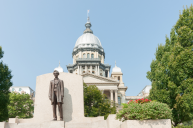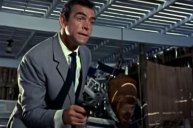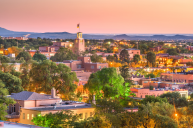There are few figures in American history as infamous as Abraham Lincoln's assassin, John Wilkes Booth. As most Americans know, Booth snuck up on the presidential box at Ford's Theatre and shot Lincoln in the back of the head on Good Friday, 1865.
However, while many people know Booth assassinated Lincoln, many don't know what was going on with the murderous actor before and after the assassination.
Understandably, even fewer folks can fathom why people leave pennies on this confederate sympathizer's unmarked headstone.
Why Did Booth Kill President Abraham Lincoln?
Depending on who you ask, it was Lincoln and not the Confederacy who was ultimately responsible for starting the Civil War. You can guess which side of the argument Booth was on.
In a letter left behind for his family members, the assassin expressed his support for Southern secession and claimed slavery was suitable for everyone involved. Similarly, Booth wrote the Latin phrase, "Sic semper tyrannis," in his journal following the assassination. This quote translates to, "Thus always to tyrants," and is commonly attributed to one of Julius Caesar's primary assassins, even though he probably never really said it.
The Roman assassin in question was none other than Marcus Junius Brutus, who happens to be the namesake of Booth's father, Junius Brutus Booth. Even weirder, Booth's father was a professional Shakespearian actor. Shakespeare wrote the famous play "Julius Caesar," which is all about the emperor's assassination and its events.
So it is that history repeats itself, sometimes with strange similarities.
How Did John Wilkes Booth Die?
https://www.instagram.com/p/CLFee3_lsX3/
RELATED: 30 Best Podcasts for Road Trips, from True Crime to Comedy
The assassin of Abraham Lincoln went on the lam with some of his coconspirators. He was eventually tracked down to the Garrett Farm south of Port Royal, Virginia. Authorities cornered Booth in a tobacco barn, and when he refused to surrender peacefully, they set it on fire to flush him out.
Ultimately, a Union soldier named Boston Corbett spied Booth reaching for his gun through the flames. Corbett shot Booth, bringing the chase to an end.
Where is John Wilkes Booth Buried?
https://www.instagram.com/p/CM8fEvWFZ3e/
Given his infamy, handlers showed booth's body little love. They first placed it in a storage room, then moved to a warehouse that was part of the Washington arsenal before reaching its final resting place elsewhere.
The body of John Wilkes Booth was eventually placed in an unmarked grave along with other members of the booth family at the Green Mount Cemetery in Baltimore, Maryland. Although Booth's body is buried in the Booth family plot, he doesn't have a headstone of his own. An obelisk with the name "Booth" at its bottom can point you in the right direction.
From there, look for the headstone covered with pennies.
Why Do People Put Pennies On Booth's Grave?
The Lincoln Assassination at Ford's Theater was one of the most heinous acts in American history. Just like the assassination of JFK, the bombing of Pearl Harbor, and the 9-11 terrorist attacks on the World Trade Center, there are some things Americans will never forget.
This being the case, people place pennies on Booth's headstone to honor Lincoln and his legacy. The idea is that people should think of Lincoln and all he accomplished when visiting the site — not the vile and treasonous acts of a fame-seeking fool.
So, if you ever visit the site, be sure to bring some pennies you don't mind parting with. If you're feeling big, you could even leave a five-dollar bill. Following tradition, be sure to place whatever you leave face up.
Strange Side Note
During his autopsy, coroners removed several pieces of vertebrae from Booth's neck. Visitors can still see them today at the National Museum of Health and Medicine in Washington, D.C.
Know some interesting facts about visiting Booth's Grave? Let other tourists know what to expect on our Wide Open Roads Facebook!




